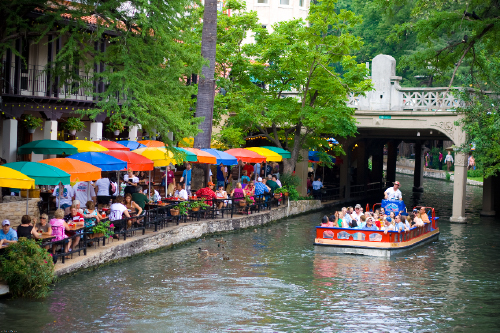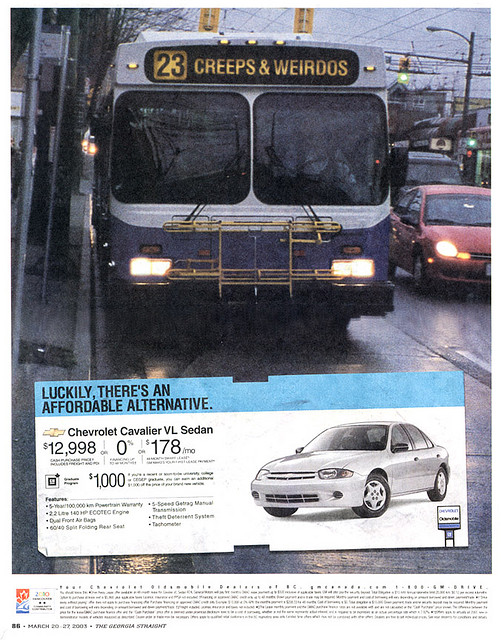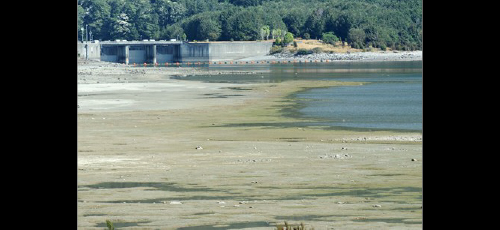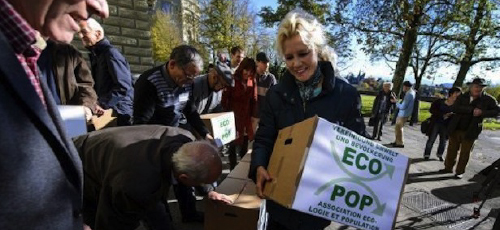Clean green dirty secrets of a future environmentalist

River Walk Worth Millions: With its engineers poised to pave over a troublesome bend in the San Antonio River, the City of San Antonio was persuaded instead to develop the San Antonio River Walk, which today is part of a broader ‘linear park’ estimated to contribute US$12.5 million annually to the city’s coffers. Auckland Council, as part of its walkable city strategy, should explore the potential for a lock and barrage system to similarly transform the Warkworth to the Wilson Cement Works reach of the Mahurangi River. photographer Colin Woon
Ozzie Zehner’s magnum opus is mostly other than about the dirtiness of clean energy.
Green Illusions: The dirty secrets of clean energy and future of environmentalism is more about the last few words of its subtitle—what the author terms: Future environmentalism.
Having said that, it is hard to fault the title. Dr Zehner (BS, engineering; MS/Drs, science and technology studies), in order to underscore the dire necessity of reducing consumption, particularly of energy, was compelled to go for the jugular. Photovoltaic has become the unquestioned byword for climate action. Only by first minutely documenting how fundamentally unsuited it and most alternative technologies are to meaningfully displace fossil-fuels, could a case begin to built for implementing existing straightforward measures to wean Westerners off their profligate but increasingly unsatisfying lifestyles. Similarly, Green Illusions demolishes the notion that electric cars can replace those directly fossil-fueled, without serious environmental consequences, largely a reflection of available battery technologies.

Feeding the Phobia: The reasonable fear that walking, cycling and public transport threatens the long-term interests of the car industry has seen General Motors launch a number of attack ads, only to reap such a backlash that the campaigns were have subsequently been cancelled. image The Georgia Straight
Energy available from the feeble human frame, or even from beasts of burden, is puny compared with that unlocked by the burning of fossil fuels. But while mechanically pumped water and electric light, for example, can make a profound difference to communities lacking either, greater energy consumption in the West has led, since 1960, to a decline in wellbeing. A familiar example is the dominance of roads and parking lots that make areas such as Silverdale’s new big box development a no man’s land for the carless. Underlining the disconnection faced by public transport users, the area’s new bus station is being built on the opposite side of State Highway 17. Unhealthy car use is subsidised and healthy walking is penalised, marginalised, and stigmatised.
The wastefully oversized packaging that pads out many supermarket lines is examined. The walker or cyclist not only has to share in paying the extra shelf real estate, and attendant contribution to the waste stream, but also is left with the burden of conveying the unnecessarily bulky products home. In one the book’s signature ‘first steps’, in this case, ‘First Steps: Smart Packaging’, Dr Zehner advocates minimising packaging dimensions, that
initiates a downward spiral of associated energy inputs.
Here and elsewhere, the author compares European practice, where supermarkets are more compact and the very supermarket trolleys are smaller. But the urgency to mobilise on climate action is such that many of the incremental changes Green Illusions advocates are insufficiently radical. In addition to the need to minimise packaging, the car needs to be removed from the mainstream supply chain. Online shopping is already here to stay, meaning that a parallel infrastructure exists that delivers commodities to the door. Online shopping has been found to involve lower greenhouse gas emissions than even shopping by bus:
Typically, when the bus has an average loading of just over nine passengers, each one of those passenger journeys produces 1265g of CO2, seven times that of an average home delivery.
Refreshingly for an American, the writer doesn’t shy away from the need for regulation. The fiction that the invisible hand of the market can magically optimise outcomes for societies would be laughable, was it not for the unrelenting misery that neoliberal ideology has unleashed. Green Illusions doesn’t dwell long on economics except to urge that a first step would include ditching gross national product as a measure of progress, and implementing monetary reform and decoupling. Decoupling is an option that the National-led government is determined to deny Aotearoa, with its privatisation of state-owned Mighty River Power. Decoupling Californian utilities, as Green Illusions reports, has led to two Californians, on average, now using the same power as one Texan. New Zealanders will find dispiriting few ‘first steps’ where their current government is not wilfully striking out in an already comprehensively discredited direction.
Dr Zehner lists five contextual preconditions that would need to be met before a nation could deploy alternative energy without simply throwing more accelerant on the fossil-fueled fire:

Neither Wind nor Rain: In theory, Aotearoa can utilise a larger proportion of wind power that most grids, on account of its large hydro storage. However, the lack of both wind and rain this summer highlights the inherent limitations of intermittent energy alternatives. Meridian Energy, which generates electricity from the lake, pictured last week, reports that February’s rainfall into Te Anau was the lowest since records began 80 years ago. image Barry Harcourt
- Consumption: The nation consumes less energy per capita than the average in the OECD.
- Human rights: The nation has a strong human rights record including a low wealth gap between rich and poor, universal health care, and low rates of murder, teen pregnancy, crime and incarceration.
- Efficiency: The nation’s car, buildings and industrial processes are more efficient than the OECD average. The nation has a binding long-term plan for improving efficiency into the future.
- Transportation: The country is in the top fiftieth percentile of walkable and bikeable urban areas in the OECD and its legislation prioritizes these communities over car culture.
- Backstops: The country has a growing energy tax and/or other backstops to stifle rebound effects.
…then judges:
Today some OECD countries meet all these preconditions. Others meet only a few. The United States meets none.
At 4.19 tonnes equivalent per capita, in 2010, Aotearoa was only slightly below the Organisation for Economic Co-operation and Development member average of 4.4, but it bombs dismally in respect to checkpoints two through five.

Energy Secretary Dr Steven Chu: ‘As President Obama said in the State of the Union, the Administration is committed to speeding the transition to more sustainable sources of energy. Innovative energy technologies, including small modular reactors, will help provide low-carbon energy to American homes and businesses, while giving our nation a key competitive edge in the global clean energy race. The funding opportunity announced [11 March] is focused on bringing innovative small modular reactors to market, creating new jobs and businesses in the United States.’
Although Green Illusions’ fundamental argument is undoubtedly sound, it is weakened by some disconcerting sloppiness. New Zealanders will be askance at the book’s assertion that cows are ‘big farters’. There is no mystery why Federated Farmers of New Zealand labelled the emissions trading scheme the fart tax—it was an irresistible opportunity to ridicule a government that had become deeply unpopular for its perceived arrogance. More serious is Dr Zehner’s uncritical citation of the non peer-reviewed report on Chernobyl co-written by co-founder of Greenpeace Russia, Alexey V Yablokov, which claims:
tens of thousands of deaths and hundreds of thousands of sick children born long after the initial meltdown.
George Monbiot, that most diligent environmental journalist with the Guardian writes:
A devastating review in the journal Radiation Protection [by] Dosimetry points out that the book achieves this figure by the remarkable method of assuming that all increased deaths from a wide range of diseases—including many which have no known association with radiation—were caused by the Chernobyl accident. There is no basis for this assumption, not least because screening in many countries improved dramatically after the disaster and, since 1986, there have been massive changes in the former eastern bloc. The study makes no attempt to correlate exposure to radiation with the incidence of disease.
The stated goal of Green Illusions is challenge readers to understand that substituting alternative energy for conventional energy is to exchange one set of unpleasant side effects for another, and that the only escape route is to significantly reduce energy consumption. In this, the book deserves to be successful; it is a beautifully written, extremely wide-ranging and readable work. But its unrelenting anti-‘productivist’ position—in this setting, the proponents of photovoltaic and wind power—lacks the nuance required to make it an entirely masterful handbook for the environmentalist.
While it is unquestionable that the West’s per capita energy consumption must be reduced, rising population and material standard of living elsewhere would negate any gains. Population is addressed more comprehensively than is usual in works on climate action. The suggested solutions, unsurprisingly, adhere to the consensus that there is no place for coercive population control, but that by respecting and resourcing women and girls, unintended pregnancies and birthrates generally will trend down. Too little. Too late—to parody Dr Zehner’s devotion to the short sentence. There is no consideration of the breeding moratorium that is the only measure that can head off famine for billions, as drought and deluge bite increasingly deeply into the productive capacity of states to feed all their citizens. The moratorium, when it begins, will be initiated and championed by young people coming of breeding age. If it begins sufficiently soon, it will be the most gloriously heroic sacrifice ever performed, and it will demand all of Green Illusions’ first steps, and more, be taken and followed through to ensure that the planet is never again left in the hands of an energy oligarchy to wantonly trash.
Dr Zehner’s clean secrets for fit-for-service alternatives such as walkable communities are the book’s joy. They are the sorts of measures that could redeem Warkworth’s proposed reincarnation as one of Auckland Council’s proposed satellite growth centres. And nor would there any need for the town to be on the Key government’s $1.65 billion ‘holiday highway’—an express bus service would reduce the emissions and expense to a fraction of that swansong to the motorway age.

No Room for Squeamishness in Switzerland: By collecting a certified 120 700 signatures, Swiss environmentalist organisation Ecopop has forced consideration of a proposed law that would cap Switzerland’s immigration at 0.2% and require 10% of its foreign aid to be used for birth control measures abroad. While the country is not a conspicuously generous source of foreign aid, at 0.45% of gross national product compared with Sweden’s 1.45%, it nevertheless puts Aotearoa to shame at 0.28%. Any climate action strategy lacking a pathway to population reduction is about as sensible as a Swiss Army knife without a blade. image AFP
In exposing the dirty secrets behind the beguiling notion that ‘free’ energy from the sun can effortlessly replace fossil fuels, Green Illusions makes a critically important contribution to the beginning of a meaningful climate action debate. But by asserting that the ‘future environmentalist’ has no business promoting alternative power generation, is as dangerous a dogma as that which the writer seeks to demolish. Australia’s percentage of coal-generated power is similar to Aotearoa’s hydro. If that hydroelectricity was not being squandered, such as for water heating during peak power usage periods, and for smelting alumina, thousands of kilometres from where bauxite is mined, Aotearoa could immediately claim to have 100% renewable power.
Aotearoa’s ‘100% renewable’ status would not endure for long, should meaningful electrification of transport be undertaken, and parts of the transport infrastructure are resistant to electrification, without giving a whole new meaning to the term Cook Strait cable. Environmentalists should be encouraged to explore the alternatives to fossil-fuel-powered shipping and air travel, beyond avoiding their use. Just the simple expedient of requiring airports to tow aircraft to and from runways would save more than half a tonne of jet fuel per flight, thereby paying for itself. And then there’s the electromagnetic catapult…
Meanwhile, back in the Mahurangi, a coastal trail connecting 900 hectares of regional parkland to the metropolitan transport system might, over time, nudge tens of thousands towards deliberate carlessness, possibly even one or two of the 39 involved in Sunday’s walk.
http://www.airbus.com/innovation/future-by-airbus/smarter-skies/aircraft-take-off-in-continuous-eco-climb/

I cannot agree with the suggestion to put a barrage on the Mahurangi River below the Cement Works. Any such action would seriously reduce the tidal prism in the harbour and thus cause increased sedimentation downstream due to the loss of natural flushing. A barrage would trap sediment coming down the river and would require eventual dredging. If anything, we should be looking for ways of increasing the tidal prism in Warkworth town such as dredging out some of the semi tidal lagoons.
The caption referred to above uses the phrase ‘explore the potential for’. The exploration envisaged would include modelling how a barrage could be operated to periodically increase downstream flows to achieve a greater flushing effect than presently occurs. If we build it, the boats will come. The greater the traffic on the Mahurangi River, the greater will be the sediment that is moved downstream. Yes, the reach upstream of the barrage would need maintenance dredging. Sea-level rise will soon outstrip the Mahurangi Harbour’s sediment accumulation rate, and then commence to significantly increase its tidal prism. Depending on the rate of sea-level rise acceleration, it is probable that a barrage could also buy low-lying areas of Warkworth a further fifty years, before retreat becomes necessary. Barrages already provide protection from storm surges in many of the world’s estuaries.
Over consumption and climate change are related but separate issues. First priority is a liveable planet. It is very difficult to sell austerity but perhaps not so difficult to sell the idea of getting off fossil fuels. By promoting alternative energy sources and taxing carbon heavily it may just give us the wiggle room to survive into a future where the problems associated with other planetary limits can be addressed.